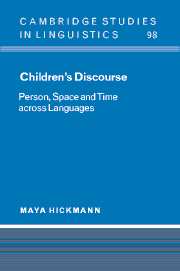Book contents
- Frontmatter
- Contents
- List of figures
- List of tables
- Preface
- List of abbreviations and conventions
- 1 Introduction
- Part I AVAILABLE THEORIES AND DATA
- Part II A CROSS-LINGUISTIC STUDY OF CHILDREN'S NARRATIVES
- 7 Methodological issues
- 8 Animate entities
- 9 Space
- 10 Time
- 11 Conclusions
- Appendix
- Notes
- References
- Author index
- Subject index
8 - Animate entities
from Part II - A CROSS-LINGUISTIC STUDY OF CHILDREN'S NARRATIVES
Published online by Cambridge University Press: 22 September 2009
- Frontmatter
- Contents
- List of figures
- List of tables
- Preface
- List of abbreviations and conventions
- 1 Introduction
- Part I AVAILABLE THEORIES AND DATA
- Part II A CROSS-LINGUISTIC STUDY OF CHILDREN'S NARRATIVES
- 7 Methodological issues
- 8 Animate entities
- 9 Space
- 10 Time
- 11 Conclusions
- Appendix
- Notes
- References
- Author index
- Subject index
Summary
In this chapter we examine how the animate characters were denoted in the narratives, while analyses concerning inanimate referents are presented subsequently in relation to spatial anchoring (Chapter 9). Recall that the compared languages vary with respect to several properties of the devices that are necessary for the marking of information status in discourse: their obligatory vs. optional nature, their global vs. local nature, and the parametric properties of the languages in relation to morphological complexity (see Chapter 3). In English, French, or German local markings (determiners) are obligatory to mark newness and global markings (clause structure) are optional for this purpose, whereas the reverse is true in Chinese. Furthermore, subjects are obligatory in English and French [–pro-drop languages], while Chinese and German allow null elements to various degrees [zero-topic languages], despite other differences between them in this respect (topic vs. subject orientation). A first set of results (Section 8.1) concerns how the animate referents are introduced in the narratives, with particular attention to speakers' reliance on local vs. global markings of newness and on the relations among these markings. A second set of results (Section 8.2) concerns the different means used for subsequent reference maintenance, with particular attention to the different syntactic, semantic, and pragmatic factors determining the forms and positions of subsequent mentions in different clause structures.
- Type
- Chapter
- Information
- Children's DiscoursePerson, Space and Time across Languages, pp. 194 - 239Publisher: Cambridge University PressPrint publication year: 2002



